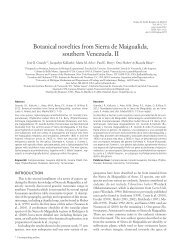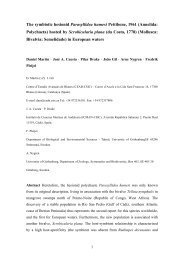FUNCTIONAL AND BIOACTIVE PROPERTIES OF COLLAGEN AND ...
FUNCTIONAL AND BIOACTIVE PROPERTIES OF COLLAGEN AND ...
FUNCTIONAL AND BIOACTIVE PROPERTIES OF COLLAGEN AND ...
You also want an ePaper? Increase the reach of your titles
YUMPU automatically turns print PDFs into web optimized ePapers that Google loves.
(Macruronus novaezelandiae) (Mohtar, Perera, & Quek, 2010) and giant catfish (Pangasianodon<br />
gigas) (Jongjareonrak, Rawdkuen, Chaijan, Benjakul, Osako & Tanaka, 2010).<br />
Although less versatile than gelatin, fish collagen has received considerable attention for its potential<br />
as an ingredient in processed functional food manufacturing, as well as for cosmetic, biomedical and<br />
pharmaceutical applications. Thus, extraction and functional characterization of acid- and/or pepsinsoluble<br />
collagen has also been reported for different fish species, like, trout and hake (Montero &<br />
Borderías, 1991), plaice (Pleuronectes platessa) (Montero, Alvarez, Martí & Borderías, 1995), squid<br />
Illex coindetii (Ruiz-Capillas, Moral, Morales & Montero, 2002), deep-sea redfish (Wang, An, Xin,<br />
Zhao & Hu, 2008), threadfin bream (Nalinanon, Benjakul, Visessanguan & Kishimura, 2008),<br />
walleye pollack (Yan et al., 2008), brownstripe red snapper (Jongjareonrak, Benjakul, Visessanguan,<br />
Nagai & Tanaka, 2005) or unicorn leatherjacket (Aluterus monoceros) (Ahmad, Benjakul &<br />
Nalinanon, 2010).<br />
Scales constitute another important fish industry residue and may account for around 5% of the<br />
material contained in fish collagenous waste (Wang & Regenstein, 2009). Utilization of fish scales<br />
for collagen or gelatin extraction has been reported for sea bream and red tilapia (Ikoma, Kobayashi,<br />
Tanaka, Walsh, & Mann, 2003), black drum and sheepshead (Ogawa, Portier, Moody, Bell,<br />
Schexnayder, & Losso, 2004), sardine (Nomura, Sakai, Ishii, & Shirai, 1996; Harada, Kuwata, &<br />
Yamamoto, 2007), grass carp (Li, Zhong, Wan, Zhao, Gu, & Xiong, 2008), deep-sea redfish (Wang<br />
et al., 2008), Asian silver carp (Wang & Regenstein, 2009) and lizardfish (Wangtueai & Noomhorm,<br />
2009). Unlike skins, scales are rich in Ca phosphate compounds such as hydroxyapatite and Ca<br />
carbonate; therefore, pre-treatment removal of Ca from fish scales is critical in order to obtain the<br />
final yield, purity, and gel strength of the gelatin (Wang & Regenstein, 2009). These authors found<br />
that pre-treatment with 0.2 mol/L EDTA produced decalcification >90%, with a gelatin yield of 22%<br />
and gel strength of 152 g, values considerably higher than those obtained with 0.20 mol/L HCl or 1.2<br />
g/L citric acid.<br />
Pre-cooked fin, an important waste product from canned tuna processing, has been proposed as a<br />
promising source for high performance gelatin extraction, though with a low yield (~2%) (Aewsiri,<br />
Benjakul, Visessanguan &Tanaka, 2008). Tuna fin presented an ash content as high as 40%,<br />
consequently an exhaustive demineralisation step was needed. Moreover, during the steam heating<br />
pre-cooking treatment, collagen might have undergone some denaturation, in detriment to the yield<br />
and the properties of the extracted gelatin, which exhibited inferior gelling, emulsifying, foaming and<br />
film-forming properties to those of commercial pigskin gelatin.<br />
6

















